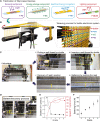Truly form-factor-free industrially scalable system integration for electronic textile architectures with multifunctional fiber devices
- PMID: 37083532
- PMCID: PMC10121163
- DOI: 10.1126/sciadv.adf4049
Truly form-factor-free industrially scalable system integration for electronic textile architectures with multifunctional fiber devices
Abstract
An integrated textile electronic system is reported here, enabling a truly free form factor system via textile manufacturing integration of fiber-based electronic components. Intelligent and smart systems require freedom of form factor, unrestricted design, and unlimited scale. Initial attempts to develop conductive fibers and textile electronics failed to achieve reliable integration and performance required for industrial-scale manufacturing of technical textiles by standard weaving technologies. Here, we present a textile electronic system with functional one-dimensional devices, including fiber photodetectors (as an input device), fiber supercapacitors (as an energy storage device), fiber field-effect transistors (as an electronic driving device), and fiber quantum dot light-emitting diodes (as an output device). As a proof of concept applicable to smart homes, a textile electronic system composed of multiple functional fiber components is demonstrated, enabling luminance modulation and letter indication depending on sunlight intensity.
Figures





References
-
- S. Sundaram, P. Kellnhofer, Y. Li, J. Y. Zhu, A. Torralba, W. Matusik, Learning the signatures of the human grasp using a scalable tactile glove. Nature 569, 698–702 (2019). - PubMed
-
- X. Shi, Y. Zuo, P. Zhai, J. Shen, Y. Yang, Z. Gao, M. Liao, J. Wu, J. Wang, X. Xu, Q. Tong, B. Zhang, B. Wang, X. Sun, L. Zhang, Q. Pei, D. Jin, P. Chen, H. Peng, Large-area display textiles integrated with functional systems. Nature 591, 240–245 (2021). - PubMed
-
- X. Tian, P. M. Lee, Y. J. Tan, T. L. Y. Wu, H. Yao, M. Zhang, Z. Li, K. A. Ng, B. C. K. Tee, J. S. Ho, Wireless body sensor networks based on metamaterial textiles. Nat. Electron. 2, 243–251 (2019).
-
- X. Yu, Z. Xie, Y. Yu, J. Lee, A. Vazquez-Guardado, H. Luan, J. Ruban, X. Ning, A. Akhtar, D. Li, B. Ji, Y. Liu, R. Sun, J. Cao, Q. Huo, Y. Zhong, C. M. Lee, S. Y. Kim, P. Gutruf, C. Zhang, Y. Xue, Q. Guo, A. Chempakasseril, P. Tian, W. Lu, J. Y. Jeong, Y. J. Yu, J. Cornman, C. S. Tan, B. H. Kim, K. H. Lee, X. Feng, Y. Huang, J. A. Rogers, Skin-integrated wireless haptic interfaces for virtual and augmented reality. Nature 575, 473–479 (2019). - PubMed
-
- M. Wang, Z. Yan, T. Wang, P. Cai, S. Gao, Y. Zeng, C. Wan, H. Wang, L. Pan, J. Yu, S. Pan, K. He, J. Lu, X. Chen, Gesture recognition using a bioinspired learning architecture that integrates visual data with somatosensory data from stretchable sensors. Nat. Electron. 3, 563–570 (2020).
LinkOut - more resources
Full Text Sources
Research Materials

